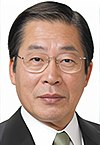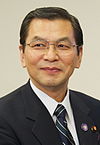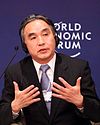Cabinet Kan (2nd reshuffle)
| Cabinet Kan (2nd reshuffle) | |
|---|---|
| 94th Japanese Cabinet (2nd transformation) dai-94-dai naikaku (dai-2-ji-kaizō) |
|

|
|
|
Prime Minister Naikaku Sōri-Daijin |
Naoto Kan |
| Legislative period | 177th NV (45th Abg . House , 22nd Senate ) |
| Appointed by | Emperor Akihito |
| education | January 14, 2011 |
| The End | September 2, 2011 |
| Duration | 0 years and 231 days |
| predecessor | Cabinet Kan (1st reshuffle) |
| successor | Cabinet Noda |
| composition | |
| Party (s) | DPJ , NVP |
| minister | 20 (2 resignations) |
| State Secretaries | 9 Special Advisor to the Prime Minister 4 Parliamentary Vice-Heads of the Cabinet Secretariat 24 "Vice Ministers" 28 "Parliamentary State Secretaries" |
| representation | |
| House of Representatives | 311/478 (24.1.2011) |
| senate | 109/242 (July 15, 2011) |
| Opposition leader | Sadakazu Tanigaki (Ed., LDP ) |
The Kan cabinet, reorganized for the second time, ruled Japan from January 14 to September 2, 2011 under the leadership of Prime Minister Naoto Kan , leader of the Democratic Party (DPJ).
Kan had tried to find partners for the budget consultations that began at the end of January 2011, but had not been able to agree on a cooperation with either Tachiagare Nippon or the Social Democratic Party . The opposition called for the replacement of Yoshito Sengoku and Sumio Mabuchi, against whom non-binding motions of censure had been passed in the Sangiin in November 2010 . It can prevent the Sangiin majority from passing the budget. After the Democratic Party's conference on January 13, 2011, Kan re-appointed his cabinet and party leadership. Most of the ministers were taken over from the previous cabinet, while cabinet secretary Yoshito Sengoku moved from the cabinet to the party leadership. Yosano Kaoru, who had left the Tachiagare Nippon the day before, became Minister of State. For the coalition partner of the Democratic Party, the New People's Party (NVP), Shōzaburō Jimi remained in the cabinet.
After the Tōhoku earthquake in March 2011 (also known as the Great East Japanese Earthquake), Kan offered LDP chairman Sadakazu Tanigaki to work in the cabinet to deal with the consequences. Like earlier, less specific offers from a grand coalition, the LDP rejected this.
On August 30, 2011, the Kan cabinet resigned before the election of a new prime minister; the successor Cabinet of Yoshihiko Noda started its work on 2 September 2011th
Minister of State
| Office | Surname | image | chamber | fraction | Faction (s) |
|---|---|---|---|---|---|
| prime minister | Naoto Kan |  |
Shūgiin | DPJ | ( Kan ) |
| Ministers of State who run a ministry | |||||
|
Minister of Internal Affairs and Communication Minister of State for the “Promotion of the Sovereignty of the Regions” (chiiki shuken suishin) responsible for the “revitalization of the regions” (chiiki kasseika) |
Yoshihiro Katayama |  |
- | - | - |
| Minister of Justice | Satsuki Eda |  |
Sangiin | DPJ | Can |
| Foreign minister |
Seiji Maehara (until March 7, 2011) |
 |
Shūgiin | DPJ | Maehara |
|
Yukio Edano (acting) |
 |
Shūgiin | DPJ | Maehara | |
|
Takeaki Matsumoto (from March 9, 2011) |
 |
Shūgiin | DPJ | Noda | |
| Finance minister | Yoshihiko Noda |  |
Shūgiin | DPJ | Noda |
| Minister for Education, Culture, Sport, Science and Technology | Yoshiaki Takaki |  |
Shūgiin | DPJ | Kawabata |
| Minister for Health, Labor and Social Affairs | Ritsuo Hosokawa |  |
Shūgiin | DPJ | Can |
| Minister for Agriculture, Forests and Fisheries | Michihiko Kano |  |
Shūgiin | DPJ | - |
|
Minister for Economy, Trade and Industry responsible for economic damage caused by nuclear power (from April 4, 2011) |
Banri Kaieda |  |
Shūgiin | DPJ | Hatoyama |
|
Minister of Land, Infrastructure and Transport responsible for maritime affairs |
Akihiro Ōhata |  |
Shūgiin | DPJ | Hatoyama |
| Environment Minister |
Ryū Matsumoto (until June 27, 2011) |
 |
Shūgiin | DPJ | Yokomichi |
| Satsuki Eda (from June 27, 2011) |
 |
Sangiin | DPJ | Can | |
| Defense Minister | Toshimi Kitazawa |  |
Sangiin | DPJ | Hata |
| Chief Cabinet Secretary | |||||
|
Chief Cabinet Secretary Minister of State for Affairs of Okinawa and the Northern Territories Minister of State for "Renewal of Administration" (gyōsei sasshin) (from June 27, 2011) |
Yukio Edano |  |
Shūgiin | DPJ | Maehara |
| Minister of State without a ministry | |||||
| Chairman of the National Public Security Commission in charge of kidnapping , reform of the civil service |
Kansei Nakano |  |
Shūgiin | DPJ | Kawabata |
| Minister of State for the Financial Sector responsible for postal reform |
Shōzaburō Jimi |  |
Sangiin | NVP | - |
| Minister of State for the “renewal of administration” (gyōsei sasshin), consumer and food safety responsible for educating people about saving electricity (setsuden keihatsu) (from March 11, 2011) |
Renhō (Murata) (until June 27, 2011) |
 |
Sangiin | DPJ | Noda |
| Minister of State for Consumers and Food Safety responsible for "education about energy saving" (setsuden keihatsu) responsible for the "normalization and relapse prevention of nuclear power accidents" (gempatsu jiko no shūsoku oyobi saihatsu bōshi) (from June 27, 2011) |
Gōshi Hosono (from June 27, 2011) |
 |
Shūgiin | DPJ | Maehara |
| Minister of State for Economic and Financial Policy, Combating the Decline of Births, Gender Equality Responsible for "integrated or fundamental social security and tax reform" (shakai hoshō, zei ittai kaikaku) |
Kaoru Yosano |  |
Shūgiin | DPJ (from January 18, 2011) |
- |
| Minister of State for “New Community” (atarashii kōkyō), Science & Technology Policy responsible for “National Strategy” (kokka senryaku), space development |
Kōichirō Gemba |  |
Shūgiin | DPJ |
Gemba (from March 9, 2011) |
| Minister of State for Disaster Management responsible for the reconstruction after the Great East Japanese Earthquake (from June 27, 2011) |
Ryū Matsumoto (until July 5, 2011) |
 |
Shūgiin | DPJ | Yokomichi |
|
Tatsuo Hirano (from July 5, 2011) |
 |
Sangiin | DPJ | Ozawa | |
The ministers of state without a ministry are naikaku-fu tokumei tantō daijin ("Minister of State at the Cabinet Office for Special Tasks"). Additional special areas of responsibility in italics.
The following were designated as possible representatives of the Prime Minister under Article 9 of the Cabinet Act:
- Yukio Edano,
- Seiji Maehara,
- Michihiko Kano,
- Toshimi Kitazawa and
- Ritsuo Hosokawa.
State Secretaries
When the Minister of State took office, the term of office of the Deputy Chief Cabinet Secretaries and the Head of the Cabinet's Legislative Office began . The prime minister's special advisers and state secretaries in the ministries were appointed a few days later, most of them being taken over from the previous cabinet.
| Office | Surname | chamber | fraction | Faction (s) |
|---|---|---|---|---|
| Cabinet Secretariat, Legislative Office | ||||
| Deputy Head of the Cabinet Secretariat |
Hirohisa Fujii (until March 17, 2011) |
Shūgiin | DPJ | Ozawa |
|
Yoshito Sengoku (from March 17, 2011) |
Shūgiin | DPJ | Maehara | |
| Tetsuro Fukuyama | Sangiin | DPJ | Maehara | |
| Kin'ya Takino | - | - | - | |
| Head of the Legislative Office of the Cabinet | Shin'ichirō Kajita | - | - | - |
| Special Advisor to the Prime Minister | ||||
| Special Advisor for National Strategy, Parliamentary Affairs (until March 17, 2011) |
Kōichi Katō | Shūgiin | DPJ | Can |
| Special advisor for integrated social security and tax reform, regulation of ministries and authorities (from March 17, 2011) |
Hirohisa Fujii | Shūgiin | DPJ | Ozawa |
| Special advisor for accidents with nuclear power plants caused by the Pacific Tōhoku earthquake (March 26 to June 27, 2011) |
Sumio Mabuchi | Shūgiin | DPJ | - |
| Special advisor for the activity of volunteer disaster relief workers (from March 13, 2011) |
Kiyomi Tsujimoto | Shūgiin | DPJ | - |
| Special advisor for the renewal of the administration and public relations (March 26 to June 27, 2011) |
Manabu Terata | Shūgiin | DPJ | Can |
| Special advisor for consumer protection and food safety, renewal of the administration (from June 27, 2011) |
Renhō (Murata) | Sangiin | DPJ | Noda |
| Special advisor for integrated social security and tax reform, parliamentary affairs (until April 2011) Special advisor for handling and providing information on accidents in nuclear power plants (April to 27 June 2011) |
Goshi Hosono | Shūgiin | DPJ | Maehara |
| Special advisor for political leadership under the primacy of politics, parliamentary affairs | Hirokazu Shiba | Sangiin | DPJ | Hatoyama |
| Special advisor for "important political measures of the cabinet as a whole" (naikaku no jūyō seisaku zempan) (from June 27, 2011) |
Shizuka Kamei | Shūgiin | NVP | - |
| Vice Minister ( Fuku-Daijin ) | ||||
| Cabinet Office | Shōzō Azuma | Shūgiin | DPJ | Ozawa |
| Yoshinori Suematsu | Shūgiin | DPJ | Can | |
|
Tatsuo Hirano (until July 5, 2011) |
Sangiin | DPJ | Ozawa | |
|
Tsuyoshi Yamaguchi (from July 5, 2011) |
Shūgiin | DPJ | Hata | |
| Internal affairs and communication | Katsumasa Suzuki | Shūgiin | DPJ | Ozawa |
| Hideo Hiraoka | Shūgiin | DPJ | Can | |
| Judiciary | Toshio Ogawa | Sangiin | DPJ | Can |
| Foreign Affairs | Yutaka Banno | Shūgiin | DPJ | Hatoyama |
|
Takeaki Matsumoto until March 9, 2011 |
Shūgiin | DPJ | Noda | |
|
Chiaki Takahashi from March 10, 2011 |
Sangiin | DPJ | Hatoyama | |
| Finances | Fumihiko Igarashi | Shūgiin | DPJ | Hatoyama |
| Mitsuru Sakurai | Sangiin | DPJ | Can | |
| Education, culture, sports, science and technology | Ryūzō Sasaki | Shūgiin | DPJ | Hatoyama |
| Kan Suzuki | Sangiin | DPJ | Maehara, Hatoyama | |
| Work, health and social affairs | Yōko Komiyama | Shūgiin | DPJ | Maehara |
| Kōhei Ōtsuka | Sangiin | DPJ | - | |
| Agriculture, forestry and fishing | Takashi Shinohara | Shūgiin | DPJ | Can |
| Nobutaka Tsutsui | Shūgiin | DPJ | Yokomichi | |
| Economy, trade and industry | Motohisa Ikeda | Shūgiin | DPJ | Can |
| Tadahiro Matsushita | Shūgiin | NVP | - | |
| Land, infrastructure and transport | Wakio Mitsui | Shūgiin | DPJ | Ozawa, Kawabata , Hatoyama |
| Shūji Ikeguchi | Sangiin | DPJ | ||
| environment | Shōichi Kondō | Shūgiin | DPJ | Kondō-hiraoka |
| defense | Katsuya Ogawa | Sangiin | DPJ | Hatoyama |
| Parliamentary State Secretaries ( Daijin Seimukan ) | ||||
| Cabinet Office | Yukihiko Akutsu | Shūgiin | DPJ | Can |
| Yasuhiro Sonoda | Shūgiin | DPJ | Hata | |
| Takashi Wada | Shūgiin | DPJ | ||
| Internal affairs and communication |
Akira Uchiyama until June 27, 2011 |
Shūgiin | DPJ | Ozawa |
| Seiji Osaka | Shūgiin | DPJ | ||
| Takashi Morita | Sangiin | NVP | - | |
|
Kazuyuki Hamada from June 27, 2011 |
Sangiin |
LDP until July 5, 2011 |
||
| Judiciary | Takahiro Kuroiwa | Shūgiin | DPJ | |
| Foreign Affairs | Makiko Kikuta | Shūgiin | DPJ | Ozawa, Kawabata |
| Ikuo Yamahana | Shūgiin | DPJ | Yokomichi | |
| Hisashi Tokunaga | Sangiin | DPJ | Maehara | |
| Finances | Izumi Yoshida | Shūgiin | DPJ | Hatoyama |
| Motoyuki Odachi | Sangiin | DPJ | Hatoyama | |
| Education, culture, sports, science and technology | Hirofumi Ryu | Shūgiin | DPJ | Hata |
| Kumiko Hayashi | Sangiin | DPJ | ||
| Work, health and social affairs | Mitsunori Okamoto | Shūgiin | DPJ | |
| Masao Kobayashi | Sangiin | DPJ | ||
| Agriculture, forestry and fishing | Masayo Tanabu | Shūgiin | DPJ | Ozawa, Hata |
|
Kenkō Matsuki until February 24, 2011 |
Shūgiin | DPJ | Ozawa | |
|
Kōichi Yoshida from February 25, 2011 |
Shūgiin | DPJ | ||
| Economy, trade and industry | Kaname Tajima | Shūgiin | DPJ | |
| Yoshikatsu Nakyama | Shūgiin | DPJ | Hatoyama | |
| Land, infrastructure and transport | Kōichirō Ichimura | Shūgiin | DPJ | |
| Toshiaki Koizumi | Shūgiin | DPJ | ||
| Shōgo Tsugawa | Shūgiin | DPJ | - | |
| environment | Takeshi Hidaka | Shūgiin | DPJ | Ozawa |
| defense | Daisuke Matsumoto | Shūgiin | DPJ | |
| Hajime Hirota | Sangiin | DPJ | ||
Resignations
- The Parliamentary State Secretary Matsuki resigned on February 24, 2011 in the intra-party power struggle between Naoto Kan and Ichirō Ozawa .
- Foreign Minister Maehara resigned on March 7, 2011 after violating the Political Money Act (seiji-shikin-kisei-hō) by accepting political donations from a foreigner .
- Reconstruction Minister Matsumoto resigned on July 5, 2011 after controversial statements in meetings with Governors Takuya Tasso and Yoshihiro Murai .
Web links
- Kantei , Japanese cabinet: 閣僚 名簿 等 (Japanese), List of Kan Cabinet Members (English)
Individual evidence
- ^ LDP Resists “Grand coalition” / Party Willing to Help with Disaster Efforts - But Not Within Cabinet. In: Yomiuri Shimbun . March 21, 2011, accessed March 20, 2011 .
- ↑ Natsuko Fukue: Ozawa Ally Quits Farm Post, Fanning Fears of DPJ Meltdown. In: The Japan Times . February 25, 2011, accessed February 25, 2011 .
- ↑ Japan Foreign Minister Seiji Maehara Resigns. In: BBC News . March 6, 2011, accessed March 7, 2011 .
- ^ Reconstruction Minister Quits After Week. Matsumoto Exit over Outbursts Puts Kan Cabinet in Deeper Mess. In: The Japan Times . July 5, 2011, accessed July 5, 2011 .